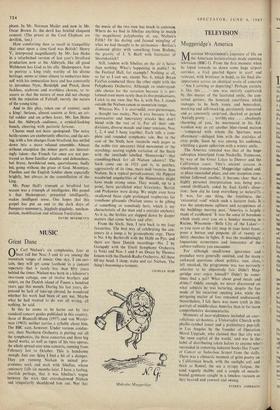MUSIC
Great Dane, OCarl Nielsen's six symphonies, four at least (all but Nos., 3 and 6) are among the mountain ranges of music. One day, am cer- " taro, they will get some foothold in a concert repertory that is rarely • less than fifty years behind the times. Nielsen was born in a labottrer's two-room cottage, one of twelve brothers and sisters, on the Danish island of Funen a hundred years no this month. During his last years, de- pressed by lack of take-up abroad, he wondered whether his work had been of any use. Maybe what he had wanted to do was all wrong, all nothing, he said. In this he seems to be borne out by two standard concert guides published in this country, those of Biancolli-Mann (1957) and von Wester- man (1963); neither carries a syllable about him. The BBC care, however. Under various conduc- tors, their Northern Orchestra is putting out all the symphonies, the three concertos and three big choral works, as well as tapes of his two operas, the whole spread over nine concerts, running from February last to October. This is handsome enough. Just one thing I find a bit of a damper. They are running Nielsen in mixed pro- grammes neck and neck with Sibelius, whose centenary falls six months later. I have a feeling, churlish perhaps, that it was Sibelius's vogue between the wars that overshadowed Nielsen And temporarily shouldered him out. Not that the music of the two men has much in common. Where do we find in Sibelius anything to match the magnificent polyphonies of, say, Nielsen's Fifth? Or his daring and fecund mingling of what we had thought to be antinomies—Berlioz's diamond glitter with something from Brahms, the gravity of J. S. Bach with foretastes of Shostakovich? Still, tandem with Sibelius on the air is better than nothing. What's happening in public? At the Festival Hall, for example? Nothing at all, so far as I can see, except No. 6, which Bryan Fairfax conducted there the other night with the Polyphonia Orchestra. Although an understand- able choice for the occasion because it is per- formed even more rarely than its five predecessors, 1 stick to my view that No. 6, with No. 3, stands outside the Nielsen canon or mountain range. Whereas No. 3 is over-mild, over-picturesque, a thought too matey, No. •6 errs because it has provocative and innovatory streaks that don't blend with the rest of it. For all their sub- divisions, diverse moods and inner tensions, Nos. 1, 2, 4 and 5 hang together. Each tells a com- plete and rounded symphonic talc. But in the case of the Sixth, how reconcile such pages as the noble (yet uncanny) third movement or the searching; searing eighth variation of the finale with the interlude; labelled 'Humoreske—that stumbling-block for all Nielsen adorers? The Sixth came out in 1925 and is, in patches, aggressively of its time, more mid-'twenties than Nielsen. In a typical period-context, the flippant woodwind angularities of the Humoreske might have made strong sense. They would, up to a. point, have paralleled what Stravinsky, Bartok and Prokoviev were doing. We might even have swallowed those eight prolonged raspberries for trombone glissando (Nielsen seems to be gibing at something or somebody here, which is un- characteristic of the man and a mistake anyhoW). As it is, the levities are slapped down by deeper matters that come before and after. From the Sixth, then, I turn back to my four favourites. The best, way of celebrating the cen- tenary in a lump is by gramophone orgy. There is No. 4 by Barbirolli with the Haild on Pye; and there are three Danish recordings—No. 2 by Garaguly with the Tivoli Symphony Orchestra (a Vox) and Nos. 1 and 15 on Decca by Thomas Jensen with the Danish Radio Orchestra. All these fillMy head. i sleep, wake and cat Nielsen. The thing's beeominga torment.
Cli ARLES REID


































 Previous page
Previous page